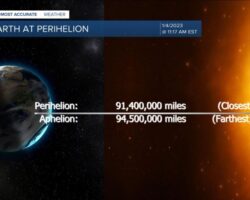Day of aphelion: Today, Earth reaches the Sun’s furthest point.

Keep in mind to wish your loved ones “Happy Aphelion Day!” Thursday denotes the point in Earth’s circle it is the farthest away from the Sun.
Aphelion is the name given to this point in an orbit. Aphelion occurs in early July, approximately two weeks after the summer solstice on Earth. Earth will be in aphelion at 4:06 p.m. EDT on Thursday. Right now, Earth will be 94,506,364 miles from the Sun, as per Timeanddate.com.
The date of aphelion next year is July 5.
Perihelion is the opposite of aphelion, and it occurs on January 4 at 91,403,034 miles from the Sun, when the Earth is at its closest point in its orbit to the Sun.
NASA Ambassador Tony Rice explains that Earth’s distance from the Sun does not entirely determine our seasons. Back-to-back solar flares that are directed toward Earth could result in dazzling auroras and power grid fluctuations. The Earth’s orbit around the sun is not perfectly circular, and neither is the Earth itself.
“In July, it doesn’t make much sense, but that’s actually not where those hot temperatures come from. “The axial tilt of the Earth is the cause of our seasons,” Rice stated.
Earth moves in an elliptical circle around the Sun while spinning on its axis.
In addition to spinning around the Sun in an elliptical (elongated circle) orbit that takes approximately 365.25 days to complete, the Earth also produces night and day. The Earth’s orbital plane is tilted in relation to its spin axis. The seasons are caused by this. It is summer in that hemisphere when the axis of the Earth points in the direction of the Sun.
Earth’s axis is pointing toward the Sun during the summer in the Northern Hemisphere, resulting in the warmth we experience during this time of year.
Rice stated, “You have to also consider that there is so much more landmass in the Northern Hemisphere, and that landmass heats up really, really easy compared to the ocean.”


